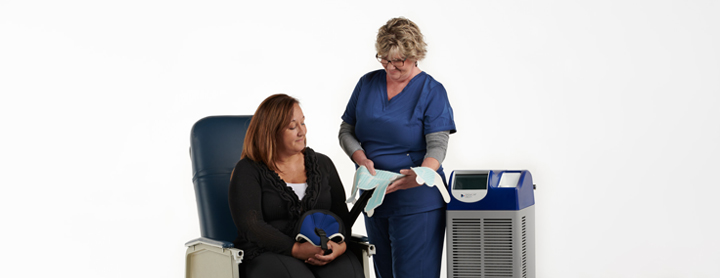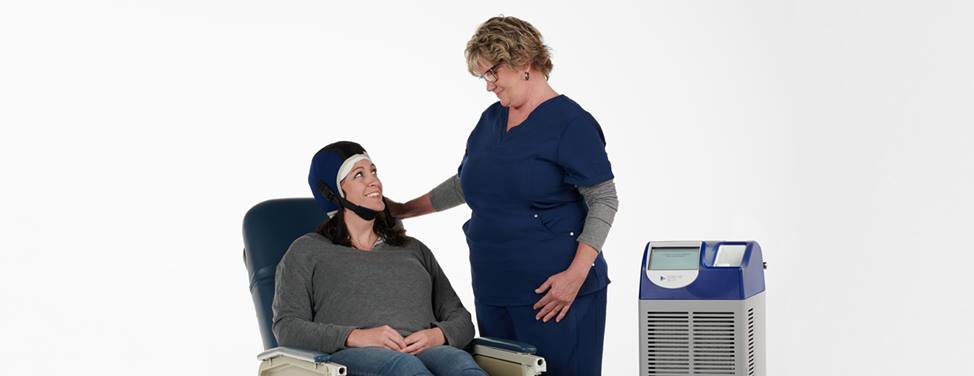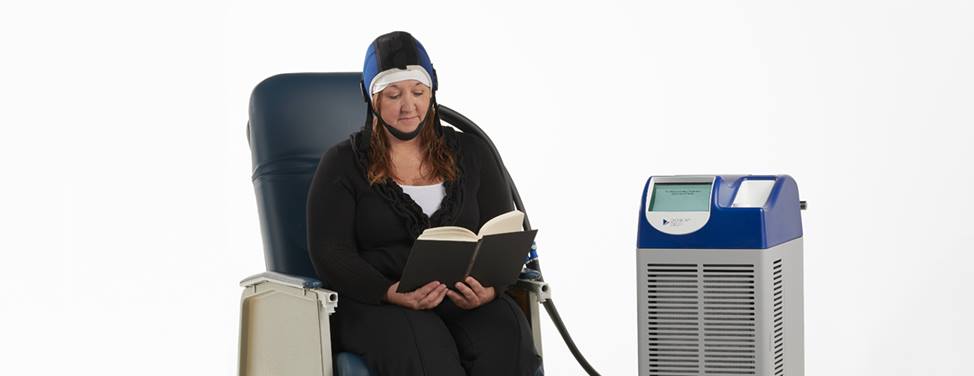Cold caps are devices that reduce the hair loss caused by some types of chemotherapy. Typically, three to four weeks after the first treatment session, damage to hair follicles from chemotherapy results in hair loss. (Hair follicles are tiny pockets in the scalp that contain the cells for hair growth.)
Cold caps work by cooling the scalp, which temporarily constricts blood flow to your hair follicles. This reduces the amount of drug that reaches your hair as well as the metabolic activity of your follicles, making them less sensitive to chemotherapy's effects.
The effectiveness of scalp cooling varies from person to person and depends on your chemotherapy regimen. While using cold caps isn't a guarantee you'll keep most of your hair, they can slow and reduce hair loss. You'll still experience thinning hair and patchy loss. Cold caps also don't prevent hair loss elsewhere on the body, so they can't help you keep eyelashes and eyebrows.
Eligibility
Most patients can use cold caps. However, you'll need your oncologist's approval if you have:
- Cancer of the blood, skin or brain
- A condition that causes significant sensitivity to cold
- Received radiation to the skull
For a list of conditions that can make cold caps less effective, visit the DigniCap website.
Deciding on cold caps
Different patients have different reasons for using cold caps, such as:
- They want to keep their diagnosis private.
- They hope that minimizing hair loss will make coping with their cancer diagnosis easier for their young children or other family members.
- They feel that maintaining an element of control or a part of their identity can bolster their mental wellness during treatment.
If you're considering using cold caps, answering these questions may help with your decision:
- Is keeping my hair during treatment important to me?
- The post-cooling time requires patients to sit for several hours. Is there any reason this would be difficult for me?
- How will longer days at the infusion center impact me?
- Can I follow the hair care recommendations for patients using cold caps?
Choosing a product
If you decide to use cold caps, you'll need to choose a product that will work best for you. At UCSF, we support two types: Penguin and DigniCap. When deciding between them, ask yourself:
- Is one of the cold cap products more affordable for me? (For information on pricing, visit Cold Cap Therapy: Costs, Insurance Coverage and Financial Assistance.)
- Do I want to complete my post-cooling sessions at home or in the infusion center?
- Do I have a caregiver who can come to my appointments to perform the capping process if I choose Penguin? If not, can I afford its white-glove service?
To compare the processes for using Penguin and DigniCap, see the table in the "Procedure" section below. Also, please consider which infusion center you'll be visiting. We can accommodate patients using Penguin at all of our infusion locations. We can support DigniCap patients at our Mission Bay, Mount Zion and Berkeley infusion centers. Learn more about DigniCap at UCSF.
Preparation
If you want to use a cold cap, your hair should be clean when you arrive at the infusion center. That means washing it the day before or the day of your treatment with a shampoo that's free of paraben, silicones, and sodium laurel sulfate. The day of your treatment, your hair must also be free of all products.
You can expect a longer infusion day when you have a cold cap session. If you plan to listen to music or watch videos while you wait, bring over-the-ear headphones instead of earbuds.
Be prepared to get cold! Wear layers. The infusion center will have warm blankets for you to use. (We cannot accommodate use of electric blankets or warmers due to fire code restrictions.) If you don't have mouth sores from your chemotherapy, bring a warm beverage to sip.
You may experience some discomfort from the coldness. Ask your infusion center nurse whether you can take a low-dose pain medication, such as ibuprophen or acetomenaphin before you start the cooling process.
If you plan to use DigniCap, please check these additional instructions.
If you plan to use Penguin, please inform the infusion staff before your first session, so they can prepare for the additional equipment and cooling time that Penguin cold caps require.
Procedure
The general procedure for your session depends on which cold cap product you use. But with either product, cold caps are worn before, during and after your chemotherapy infusion. Before putting on the cap, staff will wet your scalp with water, which helps with the cooling process. (If you have the kind of hair that gets fluffy or expands when wet, spraying it could prevent the cap from having direct contact with your scalp. If that's the case, let the infusion center staff know so they can decide whether wetting your hair is the best option.)
The cap will go on for a "pre-cooling" period, which prepares your scalp for chemotherapy. It stays on after your infusion for a "post-cooling" period. Because chemotherapy drug levels peak in your system immediately after you complete an infusion, continued constriction of blood flow to your scalp for a few hours after treatment is the best way to protect your hair follicles. The length of the post-cooling period depends on the type of chemotherapy you're getting and may include the time you're receiving medications that don't cause hair loss.
| DigniCap | Penguin | |
| Cooling mechanism | The cap is connected to a machine that circulates coolant throughout the cap. The cap's outer layer is made of synthetic rubber (neoprene). | The cap has a fuzzy exterior containing a gel polymer that stays cold after cooling. |
|
Approximate temperature |
3° C (37° F), just above freezing |
-28° to -34° C (-18° to -29° F), below freezing |
|
How to use |
UCSF staff will set up your cold cap for you. You can disconnect from the machine for stretches of up to six minutes if you need to take breaks. |
Training on the capping process is required before use. The local Penguin representative will coordinate a training session for you. You'll also receive written instructions. For an additional fee, you can request a Zoom training for caregivers. There are two storage options:
You may bring a caregiver to help you change caps.* For an additional fee, Penguin offers a white-glove service to help you change caps. |
|
Pre-cooling time |
30 minutes (done simultaneously with pre-medication administration) |
50 minutes to 1 hour |
|
Post-cooling time |
2 to 3 hours See UCSF's recommended post-cooling times for information on different treatment regimens. |
3 to 6 hours A Penguin representative will provide recommended post-cooling times for different treatment regimens. If you store your cold caps in a portable cooler, you can finish your post-cooling session at home. |
| Cost |
$250 one-time cost for the cold cap kit $325 per infusion, up to eight cycles Read more about costs, insurance coverage and financial assistance. |
$449 prorated monthly rental $200 refundable security deposit $100 per treatment for dry ice Read more about costs, insurance coverage and financial assistance. |
*The number of visitors per patient may be limited due to COVID-19 protocols. For current information, please visit our page on visitor restrictions.
Side effects
Common side effects from cold caps include:
- Feeling chilled
- Mild to moderate headaches
- Scalp pain (similar to a brain freeze)
Low doses of an over-the-counter pain medication, such as Tylenol or Advil, can limit these symptoms. For best results, take it 30 minutes before the cold cap goes on your head. If you don't bring pain medication to your appointment, feel free to ask the infusion nurse for it.
If bare skin is in direct contact with the cold cap, it can cause skin darkening and blisters. These gradually go away on their own. Protecting your bare skin can prevent this, and we will provide headbands or other shields for your skin, based on the device you use.
Hair care tips
Even with a cold cap, you will most likely experience some hair shedding or thinning because your hair follicles will be weakened by the chemotherapy. To minimize hair loss during chemotherapy, be as gentle as possible with your hair during your course of treatment and for about two to three months after completing the last cycle of chemotherapy. The following recommendations can help protect your hair:
- Wash your hair only once a week or less and use lukewarm water. Avoid hot water. Shampoo less often if your hair feels dry.
- Use only sulfate-, silicone- and paraben-free shampoos. (If you have dyed or overprocessed hair, continue using your usual products.)
- Avoid hair-styling products, such as gels and creams.
- Refrain from dyeing, heat-styling and blow-drying your hair.
- Limit combing to once a day day and use a wide tooth comb. Comb your hair before washing to remove any excess loose hairs and prevent tangling afterward.
- Don't put your hair in tight ponytails or buns. Scrunchies that let you tie your hair back loosely are preferable to rubber bands.
- Avoid hair extensions (including sew-ins, weaves, lace front wigs, braids and crochets). They can stress your hair and worsen shedding or block scalp contact with the cold cap.
- Braids, cornrows, plaits, and twists should be done loosely and in sections as thin as possible to avoid pulling on the hair and causing more shedding. Thick braids/plaits may prevent optimal contact between the cap and the scalp.
- If you have textured hair that you wear naturally, thermally straighten your hair before treatment and apply hair grease only to the ends before lightly wetting the scalp. Small twists or braids (without extensions) are permissible.
- If you have textured hair that's chemically straightened, proceed as normal with wetting the scalp. Small twists or braids (without extensions) are permissible.
- Avoid touching your hair, which can jostle the roots, and limit contact with rough materials. To protect it at night, use pillowcases made of soft, low-friction materials such as satin or silk.
- If you want to wear a hair covering, look for hats that are loose and light-weight. Avoid swimming caps and wigs; they can be too tight or too heavy and pull on your hair.
More hair care tips are available on the DigniCap and Penguin websites.











